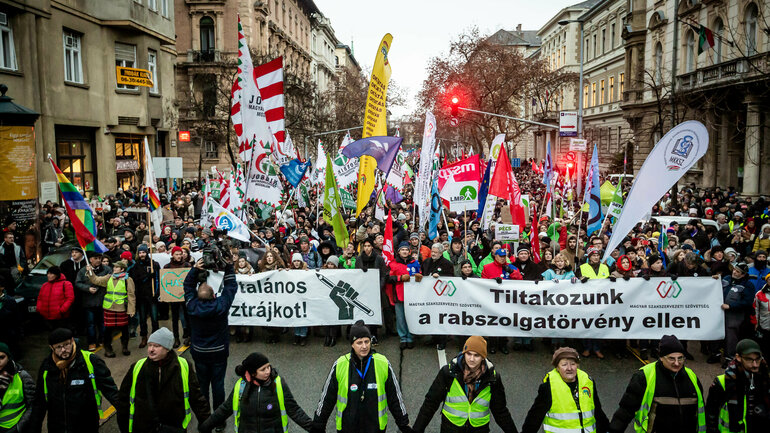Hungary’s winter of discontent

On 19 January 2019 anti-government protests took place in 60 towns across Hungary, extending far beyond liberal Budapest. This was just the latest episode in a sustained wave of protest that has swept the country since December 2018. Bringing together students, workers, civil-society organisations, and opposition parties from the centre-left, liberals, greens, and far right, the movement shows no sign of ebbing away.
Only eight months earlier, the picture was dramatically different. In April 2018, Hungarian prime minister Viktor Orbán’s far-right Fidesz-KDNP alliance won another sweeping electoral victory. With 133 out of 199 seats, the alliance secured a two-thirds supermajority in the Hungarian parliament for the third time in a row. Turnout was significantly higher than in the 2014 election, and contrary to the hopes of the opposition, high turnout favoured the ruling coalition.
Unsurprisingly, an emboldened Orbán interpreted the election result as a mandate to ‘build a new era’. In contrast, Hungary’s fragmented opposition was left in disarray. Unable to formulate political alternatives and work out a common strategy, and plagued by weak leadership and a lack of vision, opposition parties proved incapable of banking on lingering popular dissatisfaction.
Three factors can explain the emergence of the latest protest wave: culture wars, strains in Hungary’s economic model, and increasing disdain for parliament. However, while the protests are unprecedented, they are unlikely to stop Hungary’s turn towards authoritarianism.
Three contributing factors
In his speech at the 29th Bálványos Summer University in Băile Tuşnadin July 2018, the Hungarian prime minister outlined his understanding of the new era he intends to build. This would play out entirely in the cultural sphere, with the aim to create a new spiritual order. Consequently, theatres, novelists, museums, musicians, universities, and the Hungarian Academy of Sciences have all come under renewed and frontal attacks. The government has also made significant progress in its project of entirely rewriting Hungarian history. In the controversial House of Fate, the Holocaust will soon be told ‘as a story of love between Hungarian Jews and non-Jews’.
Attacks on universities and the Hungarian Academy of Sciences were what sparked the first protests. Triggered by the government’s refusal to sign an agreement that would allow the Central European University to continue its operations in Hungary, students from all over Budapest organised a ‘Free University’ with lectures, classes, and performances that attracted the support of leading left-wing and liberal intellectuals.
Students soon joined forces with a timidly reawakening labour movement that had been angered by amendments to the labour code. These amendments, dubbed the ‘slave law’, were rushed through parliament with no prior consultation. The law raises the amount of overtime work that employers can require of workers to up to 400 hours a year, and gives employers three years to calculate and pay the overtime. The slave law points to increasing tensions in the Hungarian economic model. Despite Orbán’s shrill nationalist economic rhetoric, Hungary depends on foreign investment, especially from the German car industry. But massive emigration, disinvestment in vocational training and skill formation, and anti-immigration policies have led to large labour shortages.
More than 80 per cent of industrial companies in Hungary report labour shortages as a serious problem. This is almost twice the number in neighbouring countries. Among all four Visegrád countries (a group that also includes the Czech Republic, Poland, and Slovakia), Hungary has done the least to move away from attracting foreign direct investment through tax concessions and cheap labour. While full employment threatens to raise labour costs, the slave law puts a temporary halt to this. Organised labour across Hungary has reacted with a wave of strikes and protest.
For Hungary’s opposition parties, the harsh electoral defeat in 2018, the government’s increasingly open disdain for parliament, and the almost complete disappearance of independent media have served as a wake-up call. The final trigger was the passing of the slave law and a controversial judicial reform on 12 December, which resulted in tumultuous scenes in the parliament. Since then, talks about cooperation have started in earnest.
No sign of change to come
The protests target the government and articulate increasing dissatisfaction with the Orbán regime. But their chances of changing Hungary’s course are slim. Most importantly, numbers matter. Recent research shows that if movements mobilise 3.5 per cent of their country’s population in ongoing protests, they succeed. While this does not sound much, Hungary’s protesters are far from rallying this many supporters. In addition, the protests have so far not dented Fidesz’s popular support.
Even if they had, the changes in Hungary’s electoral law, rule of law, and media landscape would make winning any election a formidable task. The upcoming European Parliament elections in May will be a good test, as they will allow the government to once more unleash its fictitious hate campaign against investor and philanthropist George Soros onto a population that has no alternative media to turn to.
Further, throughout his increasingly authoritarian rule Orbán has been able to count on the almost unwavering support of the conservative European People’s Party (EPP), and especially its German members. For the EPP, Fidesz votes are more important than liberal principles. With the EPP’s decision to appoint German politician Manfred Weber as its candidate for president of the European Commission, Orbán is safe for some time.
Europe supports Orbán’s regime in other ways too. European structural funds have provided the means to nurture crony capitalism, while European constitutional actors are unlikely to prevent him from further dismantling the rule of law. In this situation, the major challenge for Hungarian opposition parties and civil society is how to turn the energy they have displayed over the last few weeks into a long-term strategy that can rebuild liberal hegemony in Hungarian society. Here, they could take a leaf out of the conservative civic circles movement that was hugely important for building Orbán’s hegemony.
Dorothee Bohle is professor of political sciences at the European University Institute in Fiesole, Italy.